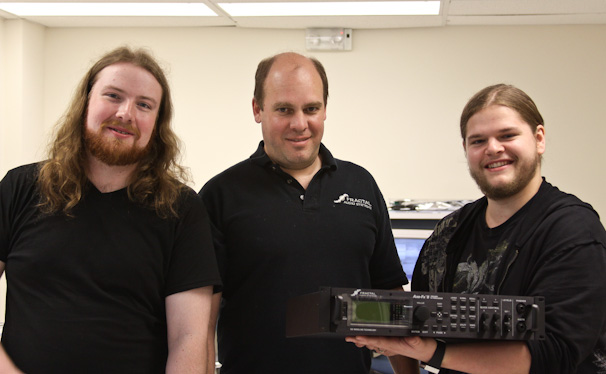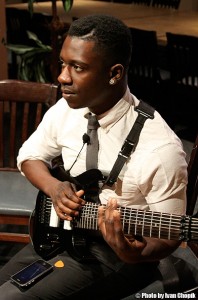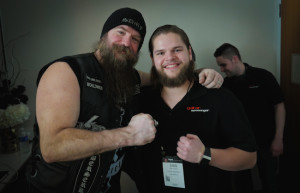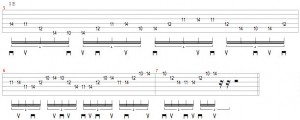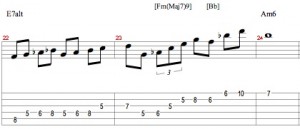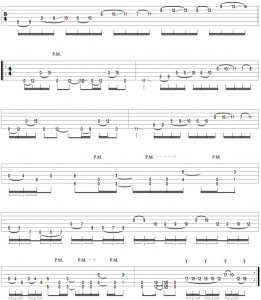As the founder of Fractal Audio and the mastermind behind the acclaimed Axe-Fx guitar preamp and effects processor, Cliff Chase has inspired the sound of legions of musicians. With his innovative approaches to amp modeling and ‘quality first’ mindset, he was able to dispel many of the misconceptions associated with digital guitar gear and provide the realism in amp modeling that has converted many tube amp aficionados’ rigs into a 2-space rack unit.

The Axe-Fx packs in an extensive collection of vintage and modern guitar amps, cabs, effects and gives its users the freedom to craft practically any rigs they want and switch through them quickly. Having become a devoted admirer of this little magic box, I was excited to visit Fractal Audio headquarters in New Hampshire and to have the opportunity to speak with Cliff himself:
IC: What’s going on in your world? Obviously, the release of the Axe-Fx II must be keeping you very busy. Can you fill us in a little bit?
CC: Yeah, the release of the Axe-Fx II consumes just about all of my waking hours at this point. We’re working on ramping up production as much as possible at the moment and trying to meet our obligations to our customers and dealers around the world. Things are going very well. We’re producing them faster than expected, so no complaints there.
IC: I know you recently added a new dealer, Tone Merchants, to the line-up. Do you have plans to add more dealers as the company grows?
CC: Tone Merchants has been a dealer of our products for probably about a year now anyway, but we mainly sell direct in the U.S., so I don’t know that we will be taking on any more dealers here. The main reason we use Tone Merchants is because the California market in particular, L.A. and Hollywood, is huge and a lot of artists go through there on their way towards U.S. tours so it’s a good location to have a dealer.
We do have dealers, of course, worldwide. We have a distributor in Europe. We just brought on a distributor in Singapore. We have Australia, Japan, another distributor just brought on in South Korea, and probably China soon as well. We’re making inroads all over the globe. [laughs…]
IC: So I want to track back and find out a little bit more about the man behind Axe-Fx. Which was first for you, engineering or guitar playing?
CC: Kinda both, you know? I started working with electronics when I was just a kid. I was fascinated with electronics from the time I was like eight years old, and I was a musician from about the same time, although I didn’t play guitar in those days. I’m a bit embarrassed about what I did play so we probably won’t go there! [laughs…] Suffice it to say, I was somewhat adept at the woodwind family.
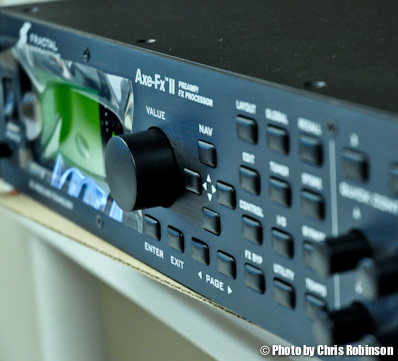
IC: You know, I played flute in sixth grade…
CC: Ok, I played clarinet and saxophone. There you go! And then one day, the turning point was when I heard Boston’s first album. That guitar tone was like ‘wow! What is that? That‘s the most amazing thing I’ve ever heard!’ And that was probably the last time I ever picked up my clarinet. I went out and bought myself a Peavey T-15 and a little crappy practice amp, and started playing until my hands hurt every day.
IC: I think they had a unit that came out in the late 80s that was supposed to model the Boston guitar tone.
CC: Yeah, everyone had a Rockman in those days. It didn’t sound anything like the Boston album. It’s kind of like a cartoon version of it.
I actually worked with a guy at my previous company who did Tom Scholz’s electronic designs for him. He said Tom was an eccentric guy, putting it mildly, but very smart and very driven.
IC: At which point would you say that you decided to pursue a career in engineering?
CC: I knew ever since I was a kid I was going to be an engineer. That’s all I did – guitar and screwing around with electronics ever since I was a little kid. In those early days I broke more than I fixed. I used to try and make my own things and sometimes it would be successful. More often than not, it wouldn’t. I tinkered with radios, and then started making my own guitar effects and all that stuff.
IC: Obviously, there was a big step between the idea of something like the Axe-Fx and actually starting work on a project like that. At which point did you decide, ‘ok, I’m going to make this unit. It’s going to do all these things,’ and then get to work to it?
CC: It wasn’t really one day I just said ‘hey, you know, I’m going to make an Axe-Fx.’ I was tinkering around with some algorithms. Actually, I had started writing stuff for PCs. I was working on some reverb algorithms and some graphic EQ stuff and kind of got frustrated with the PC environment. Then I had this development kit for the DSP we currently used, and I said ‘I wonder how well this stuff would work on that DSP.’ So I ported some of it over and I was like ‘wow! This works pretty well.’ Over the span of a couple years I said ‘you know what? I could probably make product around this.’ So that’s what I did.
I didn’t have much in the way of facilities or funds or anything at the time. So I used what money I had in savings and I built a chassis. I hired a guy to design a chassis and had some chassis built, some boards designed. Next thing you know the thing was kinda working. It was working pretty well. It was like ‘hey, yeah. This is kind of cool. Maybe I could sell this.’ I figured ‘yeah, you know, if I could sell a hundred a year I’ll probably be doing pretty well.’ I sold about that many yesterday, so….[laughs…]
IC: I heard that the first couple orders sold out in 90 seconds.
Cliff: A couple days ago we sold out in ten seconds.
IC: Ten seconds?
CC: Literally ten seconds. It was ridiculous. [laughs…] Well, people are running bots or scripts or something. They’ve got these HTML scripts or whatever that are just sitting there constantly pinging the server and then as soon as it shows as being in stock it just enters all the information automatically and places the order. But they get first in line that way. It’s a little crazy.
IC: Have you considered an effects only version of the Axe-Fx?
CC: Yeah, actually we have one in development right now. I hope to have that available fairly soon. I don’t usually like to give away what we’re working on, but that’s kind of a natural evolution of our product. It’s a floor-based product, so it uses a lot of the technology of the Axe-Fx and the Axe-Fx II, some of the four-cable method stuff I came up with, the ‘humbuster’ technology, which is actually a pretty cool thing especially if you’re interfacing with a tube amp, because you know ground loops are a pain in the neck that everyone deals with. It’s a way to fight ground loops without electrocuting yourself.
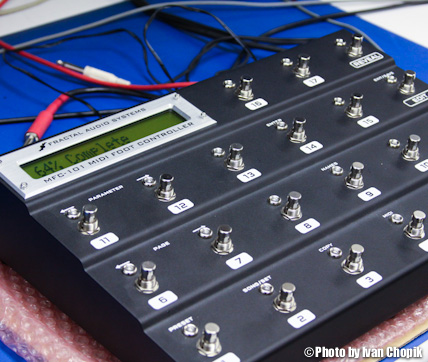
MFC-101 Footswtich
IC: We saw the Axe-Fx followed by the Axe-Fx Ultra and now Axe-Fx II. Do you suppose that there’ll be a higher level version of the Axe-Fx 2 anywhere in the near future?
CC: Can’t say! [laughs…] Probably not though, no. The Axe-Fx II would be the ‘ultra’ version, so if we were to release anything else, it probably wouldn’t be a higher end version. If anything it would probably be a stripped down version at a lower price point. But the Axe-Fx II has more memory and power than the Ultra had by far. It’s basically twice everything: twice the processing power, twice the memory, twice the DRAM memory, and like sixteen times the flash.
IC: Did you actually run out of resources on the Ultra? Were there things that you were trying to run on it that you couldn’t?
CC: Yeah, in terms of processing power it just doesn’t have enough power to run the new algorithms. It’s this thing we called G2 Modeling. It’s basically like a digital algorithm that simulates the way a tube triode works. Nowadays, when most people do modeling, they use what are called wave shapers, which is basically just a nonlinearity in math. So they’ll say you can either use polynomials or piecewise polynomials. I believe a lot [products] of the earlier company that begins with an L used a thing called a piecewise polynomial, which basically says if your input signal is over a certain value, then this is your function. If it’s between this value and another value it’s this function, and you splice all those polynomials together.
There are other approaches where you just use a polynomial or trigonometric functions and things like that. The problem with all those approaches is they are static – they’re a static transfer function. So whenever the input is here you know the output is… I mean, you can plot it on a piece of paper. You always know. Real tubes, on the other hand, have memory. They don’t have memory themselves, but they have memory due to their parasitic capacitance. Due to the actual terminal impedances, most designers will put a cathode cap on there, and a lot of times there will be a capacitor on the plate as well and possibly on the grid.
So those capacitors remember the charge that was on them, because charge can’t bleed off instantaneously. Or at least it can’t without burning up the traces on the board. So G2 Modeling is actually like a wave shaper, but it has memory, and so the transfer function changes over time based on the memory of the function. And it’s also based on the feedback and the frequency and everything else, so just like a real tube that transfers function changes with amplitude and time.
That, however, is a very CPU intensive process. It requires a lot of steps to simulate that. Simulating just one triode is almost as much horsepower as the entire modeling in the old Axe-Fx. When you start stringing together three or four triodes the algorithm is much more CPU intensive. You couldn’t run that on an Ultra and have any horsepower left for anything else, maybe just a basic delay and a reverb and something. Customers wouldn’t be very happy if they had an inventory of fifty effects and they could only use an amp, a cab, and one effect at a time. So the only way around that for the Axe-Fx II, given that we’re kind of at a plateau in DSP processing speeds right now, is to put two of them in there. One of them is dedicated to just the amp modeling and the other one does all the other stuff.
IC: We’ve talked about the amp modeling side of things. How have the effects changed?
CC: A lot of the effects are the same and again, some of the effects have been improved. The reverb block has been improved, the delay block has been improved, flanger…
IC: There’s now a ‘room’ function.
CC: That’s in the cab block, actually. Yeah, that’s a room simulation and the idea behind that is to allow you to give you more of that ‘in the room sound’ that guitar players for some reason want, even though you never put it on a disc that way. But you know, for self-enjoyment that allows you to get a more present feel. So yeah, in the cab block you can dial in the size of the room and how much of the room effect you want and how far apart the mics are and stuff like that. It adds a nice little ambience to the cab block.

IC: Did you model any particular room?
CC: Nah, it’s just a basic rectangular room. One of the things I always use is what’s called the Golden Ratio, so whenever I do things like that I make the length and width 1.61803 times the length. And the reason is that it breaks up the modes and stuff like that. The Incans, or whoever figured that one out, they knew something. It’s related to the Fibonacci sequence, all that stuff. I don’t want to get too technical. [laughs…]
IC: What could a less technical-minded guitarist expect when they first plug into the new Axe-Fx?
CC: Really good sound! That’s about as non-technical as you can get, I suppose.
IC: But I mean the Axe-Fx Ultra also had really good sound. In terms of the difference between the two…
CC: Yeah, the big difference is that the on Axe-Fx 2 it’s quicker to dial in the amp box, because they behave… in my opinion, identical to the real amps now. And the dynamics are improved, so the touch response, because of the whole triode modeling thing and the new improved power amp modeling as well, is constantly changing. The CPU is constantly figuring out new values, so as you pick lighter and harder you get differences in timbre and attack, you know?
People who grew up playing solid-state amps and modelers may not appreciate it, but the guys that graduated to tube amps and especially fine tube amps, which have that touch responsiveness, will appreciate it, because it has that very same feel and responsiveness. So if you’re a tube amp aficionado, then I think you’ll appreciate the new modeling. If you’re a guy who just likes to plug into a solid-state amp and crank the gain to 10, then you may not hear it.
IC: Probably wouldn’t be the same guy looking for high end gear.
CC: Well, you know, you can get that sound, too. Some people actually like that stiff, sterile solid-state sound. I mean, it worked for what Dimebag Darrell did. But I think most guitar players; once they’ve played through a good tube amp go ‘wow, you know, I’ll never go back to solid-state again.’ I remember when I played my first good tube amp I was like ‘wow, what a difference!’ Of course, in those days solid-state amps were terrible anyways…
IC: You must have quite the tube amp collection.
CC: I have an awesome collection. [laughs…] I think I have like thirty-seven tube amps now. I have just about every amp in the Axe-Fx II except the real esoteric ones like the Dumble or Train Wreck because, you know, I’m not going to take a second mortgage to buy a tube amp. But I’ve got all the other ones. I scoured eBay and Craigslist and the ‘for sale’ sections of forums for the last few years collecting amps. I made a really nice closet find – it was a 1974 Hiwatt DR504. Looks like it just came out of the box, still had the original tubes in it.
IC: That’s a find!
CC: Yeah, it is a find. And I have an old blackface Soldano SL0100. I’ve got the Friedmans, a ton of Bogners and [Mesa] Boogies and Marshalls and VHTs, you name it.
IC: Is there anything you can tell us about the upcoming firmware updates?
CC: No, usually right after we release a project the next firmware update is bug fixes, but strangely I haven’t received any bug reports, so that’s a good thing. This time we had a team of about seven beta testers and the product was in their hands for 2 to 3 months and we went over it with a fine-toothed comb and I think we got ‘em all.
Most of them were just, you know, spelling errors and little stupid things like when you click on this thing it doesn’t do what it’s supposed to do. So there weren’t any glitches in there. Of course, there’ll always be more amp models coming out and some new effects. The Axe-Fx II also has what are called ‘effect presets,’ so it makes dialing in the sounds a lot easier now. For example, in the phaser block you can set it to Script 90 and it’s all done.
IC: That’s the classic sound you’re looking for.
CC: Yeah, so you know, there’s room to add more presets to the individual box. That’s probably something we’ll be working on as well.

Misha Mansoor a.k.a. Bulb playing his Axe-Fx
IC: I heard there’s a new preset called ‘Djentlemanly?’
CC: I did that one. [laughs…] I based that on Bulb from Periphery, who’s a big Axe-Fx guy. He’s a really nice and talented guy. I had some information on how he set up his presets and I based that around his sound. Don’t know how close I got, ‘cause he hasn’t got one yet, so I’ll be interested to hear his feedback on it.
IC: As a guitar player, are you in a band now?
CC: I am not anymore, because I’m too busy trying to deal with maniacs on the forum. [laughs…] Up until about two, three years ago I was, but I just got too busy. My chops are gone, too. I can’t play worth a damn anymore.
IC: What’s your style as a guitar player?
CC: Prog rock – big Rush fan, big Steely Dan fan. I played in a Steely Dan tribute band for about a year actually. It was good, but the pay stunk. You know, there’s not a huge audience for Steely Dan tribute bands. I liked it all. I’m not big into the modern metal scene, but probably because I’m just old. [laughs…] I loved 80’s hair metal and stuff.
IC: What was your rig like?
CC: The last rig I had was an Axe-Fx Ultra into a Carvin power amp into a 4×12.
IC: Is that the rig that you test against when you A/B with the amps you’re modeling?
CC: When I A/B, I have a 4×12 Mesa stereo cab that has a baffle right down the middle and stereo inputs in the back. It’s great! It’s got Black Shadow 90s in it, I want to say. Everyone says it’s one of the best cabs they’ve ever heard for whatever reason. It gets loud. But when I A/B against the real amps what I do is I have an A/B/Y switch.
I plug my guitar into the Y and then A goes out to the real amp and B goes into the Axe-Fx II and then the output of the real amp goes into the left side of the stereo cab and the output of the Axe-Fx II goes into a solid state power amp into the right side of the cab. Then all I have to do is hit the A/B switch and then I can quickly go back and forth between the two and make sure it sounds like I expect it to sound.
Of course before all that, there are all kinds of measurement steps that are done. We sweep the amps and put test tones in. I also have some special jigs I’ve created that allow me to extract the output transformer parameters, usually without having to pull the amp all apart. Although half my amps are in pieces all over the floor right now. [laughs…]. There are certain things you have to measure. You have to measure the output transformers and things like that to get their various parameters.
IC: How close are the A/B tests this time around?
CC: I think they’re spot on. I do. I do double-blind testing with my wife. ‘Alright, which one’s which?’ and she can’t tell. When I was first developing the new modeling I used an export version of a [Marshall] JCM 800 as my reference to the work on the modeling, because it was the best sounding JCM 800 I’d ever heard and I spent months just going back and A/B-ing, listening for the subtleties and trying to figure out ‘yeah, there’s something a little different there.’
I did discover a few things that I don’t think anyone realizes right now. There are certain dynamic interactions between the tone stack and things around the tone stack that I don’t think most people in the modeling business realize. That’s all I’ll say about that. [laughs…] But we figured out how to model that. You can hear the difference. Hidden in the software is a switch. In the debug version of the firmware there are actually dozens of parameters that you can adjust and turn things on and off, so that you can actually listen to the effect that they have on the tone.
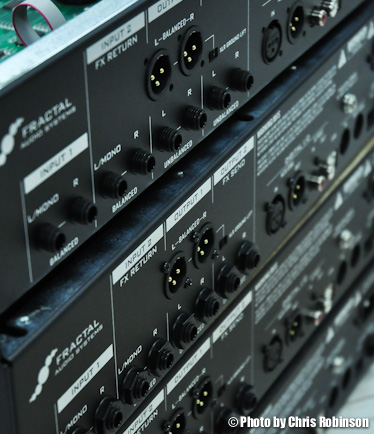
But we don’t expose them for the users for a variety of reasons. One is that most of them wouldn’t understand what any of them mean anyways, and the second is that you don’t really want to tip your hand to what’s going on behind the scenes. Once I figured out some of the subtleties of what was going on there, it sounded dead on to me. It’s just fun doing that, you know? Get paid for trying to digitally clone a tube amp is a pretty good job. It beats what I used to do anyways.
IC: In another interview you mentioned the idea of possibly porting some of the Axe-Fx features into VST [virtual studio technology] plug-ins.
CC: Yeah, it’s something we’ve been investigating, actually. We have a working PC version. The only reason we haven’t released it is the piracy issues. If someone were to pirate it, it could have a detrimental effect on sales. So I’m not sure that’s something that we want to do right now. Unless we can guarantee that the product can’t be pirated, I don’t know that we want to release it. And plus there’s free stuff out there now, too. Getting into the software market is not very lucrative anyway. Anyone with a computer and a Microsoft development kit can write a plug-in, you know? How good they are is questionable. I think some of the free ones are actually half decent now.
But the other problem with plug-ins is that you’re at the mercy of your audio interface. And for guitar, most of your audio interfaces are terrible. They’re either the wrong impedance or they’re the wrong level, and then you get all that latency on top of it. A PC is the worst thing in the world for trying to do low-latency audio.
Even the manufacturers will say, ‘oh, it’s only five milliseconds of latency.’ Yeah, well it’s five milliseconds just in the part that you’re telling us about, but you’re also going to get at least a millisecond in on your USB bus, another millisecond out, maybe another couple milliseconds in the driver, so their five millisecond advertised latency often ends up being twice that. You’ve probably played plug-ins that have a slight delay that is just enough to drive you nuts.
They’ve done studies that showed once you get past a few milliseconds of latency it messes with your timing. And oddly enough once you go over another threshold, I think between three and twelve milliseconds, it screws your timing all up. Once you go beyond twelve, and especially once you go beyond twenty, you actually start to compensate, which is why musicians who play in large groups when they’re separated by pretty large distances can all gel together, because your brain kinda figures it all out.
The reason the study was done was they were talking about online collaboration so that you would be able to basically play in an ensemble, but over the Internet. But of course you got the latency issues of audio-over-IP type stuff so naturally you’re going to incur quite a bit of latency that way. Surprisingly they found out that people can deal with it, they’ll anticipate the latency. But it’s in that in-between range that it screws you up.
I think part of it is because you hear the strings but you can’t hear the audio, so you get that slight delay and it makes the strings feel funny. But anyways, that gets back to the point that you’re at the mercy of your audio interface and PCs are really terrible. They were never designed for real-time processing. When you make your own hardware, you design it to be a real-time system and latencies are ridiculously low because that’s what we design for – extremely low latency. So, will we come out with a PC version? I don’t know. I’ve got other irons in the fire right now.
IC: Where do you see Fractal Audio in ten years? What’s your ultimate goal?
CC: My ultimate goal is to be on a beach drinking a margarita… no. [laughs…] I’m not looking for explosive growth. I just want to grow the company steadily. It’s always been my philosophy that it’s quality first. We kind of cater to an exclusive clientele. It’s never going to be your Musician’s Friend or Guitar Center product, although we are working on some products that are at a more aggressive price point that may work their way into the brick and mortar retail chain. I don’t know yet, but the emphasis is always going to be quality. I think we have a bit of a niche there, anyway.

Which one’s yours?
It’s really, really competitive in the low price range. You’re competing with Boss and Digitech. Everyone’s got pedals and low-cost stuff and it’s all mass-produced in China, and for most musicians, they’re fine products. It’s just that we cater to the individual who, when they buy something, they want the best and they want something that’s gonna last. Because that’s what I want when I buy things. If I’m looking for something and you got the sort list I always sort highest price to lowest price, because I want to see what the best stuff is.
Unless, of course, I’m buying something stupid, then I only care about the lowest price. But if I’m buying a refrigerator or a new monitor, I sort highest price to lowest price. I don’t want to have to buy a new monitor in a year because that one crapped out or I’m not happy with it. So that’s the clientele we cater to.
IC: I think there’s a British saying that goes ‘It’s too expensive to buy cheap.’
CC: Well, it is. I remember years ago I bought an inexpensive drier and two years later the thing broke. It was just out of warranty and it was like ‘I gotta buy another drier now.’ If I had bought the expensive one which wasn’t even twice the price, it would’ve lasted probably twenty years and not had to be replaced again. Buy it once; keep it for a long time. I think most of the Axe-Fx and Ultra guys have had their units for 3, 4, 5 years now. They’re still going strong and they’re still getting the utility out of it and making records with them. They probably paid for themselves umpteen times over.
IC: You mentioned how you see the company growing. How big is the crew now?
CC: We’re only seeing part of the crew right now [at Fractal HQ]. We have a lot of people off-site. In here, we have five people, a couple engineers, and Matt Picone – he’s the man. I’m bringing on another engineer next month; a guy by the name of Adam Cook. He used to work for Analog Devices. He worked in their DSP group so we’ll have another engineer so we can start developing even more products. The future looks bright. I got my shades.
IC: Best of luck with all that!
CC: It’s not luck though, you know? You just got to execute right and not be burdened by people with bad ideas and too concentrated on the bottom line. You get into a lot of companies and the accountants start calling all of the shots and they don’t see the big picture. One of the things I vowed when I left my last company was not to let the accountants design the products, you know? Let the people who actually use them design them. The other guys can figure out how to price them afterwards.
If you make it good enough they will come. I didn’t know that at the time though, but that was my philosophy and I said I’m going to give this a try because at my old company the bean counters would drive you nuts trying to nickel and dime everything. With this company I said I’m going to design it the way it should be designed and then set the price after it’s developed and if people buy it, they do, and if they don’t… well, then I’m only out my life savings! [laughs…] It can be good if you don’t cut corners, that’s all.
And the price is going to come down. You know, we’re at a turning point now in terms of how much horsepower you get for your dollar. And you do need a lot to do it right. You remember those things from the 90s that had six hundred effects and they all sounded terrible because they cut every corner they could to fit those algorithms in a thirty megahertz chip or something – no wonder it sounded terrible. If they only did one thing, they’d have been fine. But when you try to fit delays, reverbs, and all that stuff all at once then, you know…
IC: In theory, if you have the processing power than there’s no reason why digital shouldn’t work, right?
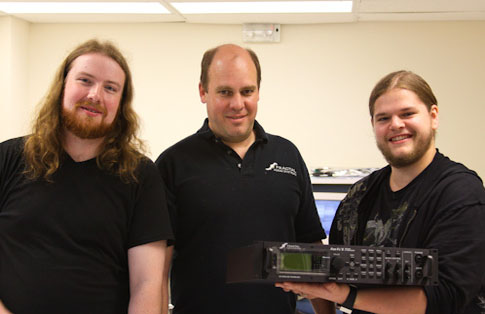
Chris Robinson, Cliff Chase, Ivan Chopik
CC: You’re going to have people arguing semantics against that, but there’s nothing magical about analog. You’re just manipulating electrons. If you can figure out exactly the way the analog stuff is manipulating the electrons, you can come up with a formula and implement it so that it manipulates numbers in the exact same way. It’s not magic. But unfortunately some people can’t get around that fact. They think that there’s something magical happening there and there actually isn’t. All the principles are very well understood now.
We know how electronics work because we’ve been studying electronics for a hundred years now ever since the light bulb. The hard part is just duplicating the behavior with a formula. First you gotta figure out the formula, the mathematical expression, and once you get that, then you gotta code it as efficiently as possible. Of course, in the case of a vacuum tube the formula is actually pretty complicated and coding it requires a lot of horsepower.
But it’s a good time now, because DSPs are becoming incredibly powerful and relatively inexpensive and it’s only going to continue to go that way. Even the simple laptop is ridiculously powerful. Now if they could just get the latency issues under control it’d be a great platform. It’s great for post-processing though. It’s back to the whole VST thing. I don’t know if I’d want to bring a laptop on stage anyway. I’m not that bold.
IC: You were saying how PC’s were not designed for real-time processing. Has anybody tried to tackle that issue and design a new real-time operating system?
CC: Sure. Guys have done it and come and gone. Remember BeOS? It was an operating system and I believe one of its claims to fame was that it was mostly real-time. One of its design goals was that it was built to handle audio processing. I remember seeing a demonstration where they were playing back a hundred and twenty-eight mp3 streams all at the same time on it. But unfortunately it’s Windows and Apple and maybe Linux on the fringe.
IC: Fractal Operating System?
CC: Well, we use our own operating system on our stuff, but it wouldn’t port to a PC easily. It isn’t designed to host anything but our own stuff. People have tried to write new operating systems and BeOS was a great example of just tilting against windmills – not gonna happen. So we’re stuck with what we have, for better or worse.



